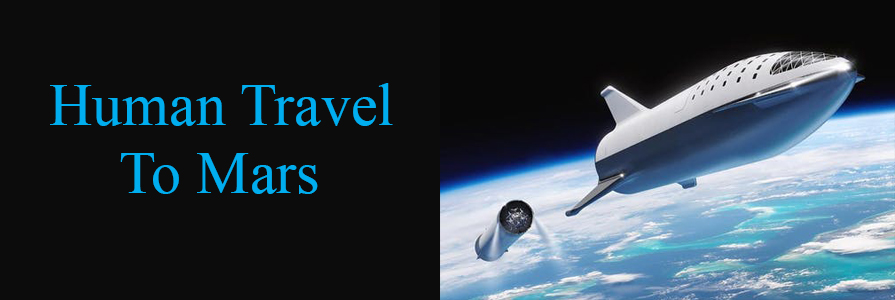
How Far Is A Trip To Mars?
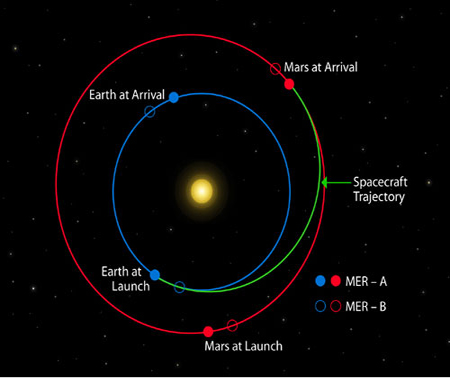
How far is a trip to Mars from Earth? That seems like a simple question, but the answer is quite complicated. At times when Mars is closest to the Earth - it is only 34 million miles away. At other times, because of the differences in the orbits, Earth is on one side of the Sun and Mars is on the other - 249 million miles away (a 215 million mile difference from the minimum). However, Mars on average is 140,000,000 miles from Earth. (For reference purposes, on average the moon is 240,000 miles away, and the International Space Station (ISS) station is 254 miles.)
When speaking about a trip to Mars, the correct question is how many miles would the "ideal trip" be - a more complicated question? Looking at the diagram to the left, the green line illustrates the length of a one way trip with today's technology. The length and time of the trip depends on the amount (weight) of fuel one can afford, the type of propulsion system needed to exit the Earth's atmosphere, and the propulsion system to fly the distance to Mars and back. (As they say, it takes a rocket scientist to figure all this out.)
The orbit of Mars around the Sun is 1.9 Earth years, so its orbit is significantly bigger than the Earth's orbit. This makes the minimum distance between the two planets to occur about every two years. If the fact that the Earth is also revolving simultaneously is taken into account, the minimums actually occur about every 2.1 years. Therefore trips to Mars are planned in launch windows about every 26 months.
The travel time to get to the ISS station is about 6 hours and about 3 days to go to the Moon. The one-way journey time from Earth to Mars will take between 150 to 300 days depending on the size and power of the launch, the alignment of Earth and Mars, and the speed of the spacecraft on the way to the target. It really depends on how much fuel one is willing to burn. The more fuel, the shorter the travel time, but the higher the cost. Top
Non-Human Trips to Mars
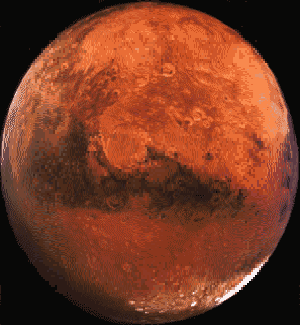
The first spacecraft ever to make a successful journey from Earth to Mars was NASA’s Mariner 4, which was launched on November 28, 1964 and arrived at Mars July 14, 1965. It was a fly-by journey and took 21 photographs during the visit. Mariner 4’s flight time was 228 days.
The next successful mission to Mars was Mariner 6, which blasted off on February 25, 1969 and reached the planet on July 31, 1969, a flight time of only 156 days. Mariner 6 returned 75 photos.
The successful Mariner 7 only required 131 days to make the journey and it returned 126 images. Mariner 4, 6, and 7 were all fly-by operations.
Mariner 9, the first spacecraft to successfully go into orbit around Mars, launched on May 30, 1971, and arrived November 13, 1971 for a flight duration of 167 days. Mariner 9 returned 7,329 images.
Here are some more recent US examples of the flight times to get to Mars:
Opportunity rover landed in 2004 - 202 days - lasted over 14 years on Mars
Phoenix rover landed in 2008 – 295 days - lasted 6 months, completed all planned experiments
Curiosity rover landed in 2012 – 192 days - as of August, 2019 has lasted over 7 years and is still operational
-
InSight rover landed in 2018 – 174 days - as of August, 2019 InSight has lasted over 9 months and is still operational
The "lowest energy" round trip to Mars is called a Hohmann transfer orbit, which would involve approximately 9 months travel time from Earth to Mars, about 17 months at Mars to wait for the next transfer window to Earth, and a travel time of about 9 months back to Earth. This totals 35 months - almost 3 years away from Earth.
The times of the travel pattern have held up for over 50 years of Mars exploration - it takes approximately 150 to 300 days to get to Mars. All the trips so far have been without any humans.
Much More Complicated To Send Humans
All the above missions were robotic missions with space vehicles that were significantly lighter than a spacecraft carrying astronauts, supplies, and fuel for a round-trip. Developing systems for a manned mission to Mars will require a careful balancing act between minimizing the weight and figuring out how to use the least amount of fuel possible. One of the biggest engineering issues designers are facing is dealing with the amount of fuel that will be needed to send a spacecraft on such a long round trip. More fuel means more weight, and more weight means the need for more fuel to transport that weight.
A program for a crewed mission to Mars estimated it would need to send into space about twice the mass of the International Space Station - roughly 1.8 million pounds. To launch the equipment, the plan would be to use the most powerful rockets ever built capable of carrying about 400,000 pounds. The complete Mars system would be sent to a permanent station in orbit around the Moon (possibly to a permanent station on the Moon itself.) When all has been transferred to the Moon station and the preparations finalized, a spacecraft would fly from the Moon to Mars. The total system to send humans to Mars is incredibly more complicated and expensive than to just send robots. Top
On The Way To/From Mars - The Radiation Issue
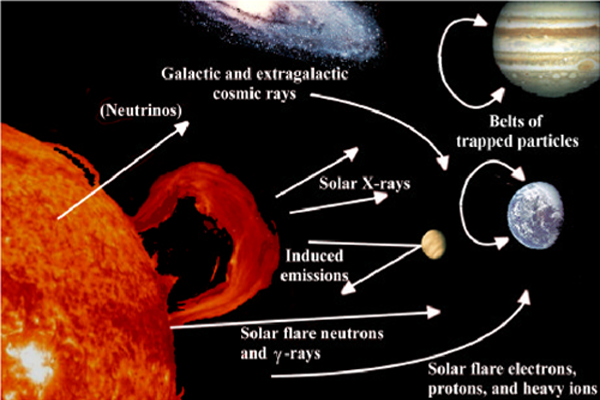
The ISS space station sits just within Earth’s protective magnetic field, so while our astronauts are exposed to ten-times higher radiation than on Earth, it’s still a much smaller dose than what deep space has in store.
Although it requires patience for a robotic type spacecraft to travel most of a year to reach Mars, we might want a faster propulsion system if we’re sending humans. Space is a hostile place, and the normal radiation of interplanetary space poses a long term health risk to human astronauts. See the outer space illustration to the left.
The background of cosmic rays from deep space supernova explosions and other violent events inflicts a constant barrage of radiation. In addition, our Sun normally emits dangerous neutrinos, x-rays, and solar flares. A thicker spacecraft hull could help block lower-energy cosmic rays, but high-powered rays would still easily pass through.
High doses of cosmic and solar rays can have adverse affects on the central nervous system, such as: impaired cognitive function and motor skills, behavioral changes, and an increased risk of developing fatal cancer at some point in any given astronaut's lifetime. Extreme exposure could lead to radiation sickness, and symptoms which include nausea, vomiting, fatigue, and loss of appetite. And, there’s always a risk of a massive solar storm, which could definitely induce cancer and/or possibly kill unprotected astronauts in a few hours.
To mitigate the radiation hazard, deep space vehicles will have significant protective shielding, dosimetry, and alerts. (Dosimetry is the measurement of the amount of radiation absorbed by a substance or living organism by means of a dosimeter.) Research is also being conducted in the field of medical countermeasures such as pharmaceuticals to help defend against radiation. Top
If you can decrease the travel time, you reduce the amount of time astronauts are getting pelted with radiation. It will also minimize the amount of supplies they need to carry for a return journey. The NASA "goal" is to reduce the travel time to and from Mars from 9 months down to about 6 months.
Hazard - The Lack Of Earth Gravity
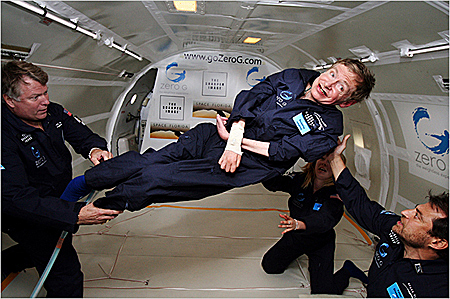
The variation of gravity that astronauts will encounter is a major hazard of a human outer-space mission. On a reduced 6 month trek to and from the planets, explorers will experience total weightlessness for about 12 months. On Mars, astronauts will need to live and work in three-eighths of Earth’s gravitational pull for about 17 months before they can begin the trip back. That is about 29 total months of weightlessness. (Pictured to the left is Steven Hawkin during a deep jet plane dive that produces weightlessness for a very short period of time.)
To further complicate the problem, when astronauts transition from one gravity field to another, it’s usually quite an intense experience. Blasting off from the surface of a planet or a hurdling descent through an atmosphere is many times the force of normal gravity.
Besides Mars and deep space, there is a third gravity field that must be considered. When astronauts finally return home they will need to re-adapt many of the systems in their bodies to Earth’s gravity. Bones, muscles, and the cardiovascular system will all have been impacted by years without normal gravity.
According to NASA, astronauts, who spend many months on a space mission, can lose on average one to two per cent of bone mass each month - i.e. osteoporosis. Osteoporosis (which literally means porous bone) is a disease in which the density and quality of bone are reduced. As bones become more porous and fragile, the risk of fracture is greatly increased. Astronauts typically experience bone loss in the lower halves of their bodies, particularly in the spine vertebrae and the leg bones. The loss of bone occurs silently and progressively. Often there are no symptoms until the first fracture occurs. NASA is identifying how current and future FDA-approved osteoporosis treatments can be employed to mitigate the risk for astronauts developing osteoporosis. Top
Making Spacecraft Habitable
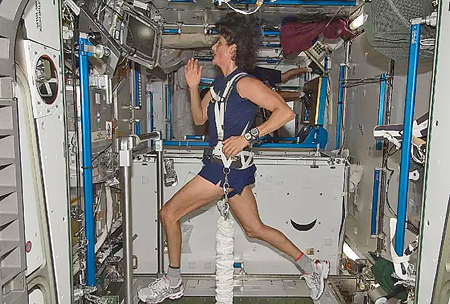
A spacecraft is not only a machine, it is also a home. NASA understands that the ecosystem inside a vehicle plays a big role in everyday astronaut life. The ISS, for example, uses an LED lighting system that was designed to mimic light on Earth. The interior design of a space craft attempts to keep the environment as comfortable as possible for astronauts.
Important habitability factors include temperature, pressure, lighting, noise, and quantity of space. It’s essential that astronauts are getting the requisite food, sleep and exercise needed to stay healthy and happy. (Pictured at the left, astronaut Sunita Williams exercises on the ISS treadmill using a bungee harness to keep herself positioned.)
Technology comes to the rescue in creating a habitable home in a harsh environment. Technology aboard current and future spacecraft will have to use limited resources well; for example, turning astronauts' carbon dioxide back into breathable air and their urine back into water. Everything will be monitored, from air quality to possible microbial inhabitants. Micro-organisms that naturally live on your body are transferred more easily from one person to another in a closed environment.
Astronauts do contribute important scientific data via their urine and blood samples. They can also reveal valuable information about possible stressors. Space travelers are asked to provide feedback about their living environment, including physical impressions and sensations, so that the evolution of spacecraft can continue addressing the needs of humans. Top
Long Ride Issues
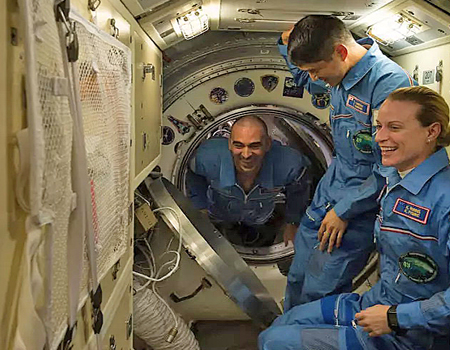
NASA expects the eventual journey to Mars to take about 6 months (down from the "lowest cost" time of 9 months), which means that astronauts' living quarters need to be comfortable enough to keep the space travelers both physically and mentally healthy. Humans who make the long space journey will experience health risks we have never faced before
The living conditions in space need to simulate those on Earth as much as possible. Also space travelers must be encouraged to stay active and motivated. Extensive recycling of resources we take for granted is also imperative: oxygen, water, carbon dioxide, even our waste.
In space, stress hormones are elevated, according to a research program, and this can alter a person's immune system and make them more susceptible to allergies and other illnesses.
If a medical event or emergency happens on the ISS station, the crew can return home within hours. Additionally, cargo vehicles continually resupply the crews with fresh food, medical equipment, and other resources. Once you burn your engines for Mars, there is no turning back and no resupply. Planning and self-sufficiency are essential keys to a successful Martian mission. Facing a communication delay of up to 40 minutes (20 minutes each way) and the possibility of equipment failures or a medical emergency, astronauts must be capable of confronting an array of situations without support from their team on Earth. Top
Human To Human Issues
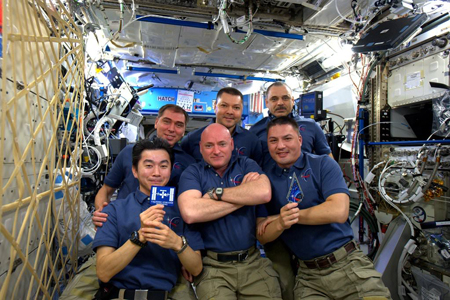
Sending people to Mars is a daunting prospect. It would take astronauts at least 6 months to get there. They might spend 17 months on the planet itself, and they would then spend another 6 months on the journey home. During those 29 months they would be exposed to the irritating habits of their fellow crew members.
NASA envisions a crew of six astronauts for a Mars mission. That is what's required for the skills needed - a commander, scientist, engineer, medical officer, as well as pilots. Expertise and cross training in a wide range of disciplines will be required. Pictured at the left is Captain Scott Kelly (center, one of the twin Kelly brothers) along with five other members of ISS Expedition 45 in the fall of 2015.
Something researchers have already learned from prior space travels is that certain personality characteristics are essential to help groups work well together. A good group needs a leader, a social secretary, a storyteller and a mixture of introverts and extroverts. By far the most important role seems to be that of the "clown."
According to Jeffrey Johnson, an anthropologist at the University of Florida who has spent years examining relations between people in Antarctic crews wintering at the South Pole, the clown is not only funny, he is also smart and knows each member of the group well enough to defuse most of the tensions that arise during long periods of close contact. This sounds like the role of a jester in a royal court. The clown also acts as a bridge between different groups of people. In groups that tend to fight or to lose coherence, there was usually no clown Dr. Johnson found.
Even if a perfect, balanced group of astronauts is assembled for a Mars mission, things could still go awry. On December 28th 1973 for example, the three crew members of Skylab, an early American space station, decided to cut off contact with ground control. They refused to do any of their assigned tasks - something they called a “work slowdown”. Newspapers at the time referred to this incident as the first strike in space.
Because of the 40 minute delay in communications with the ground support crew on a Mars trip, NASA’s engineers are working on software that can be used to analyze data about a crew’s behavior in real time. This would provide a local digital counselling service, helping them find ways to mitigate any issues. “Good mental health on a mission is not the absence of conflict, but how you handle that conflict,” said Thomas Williams, a specialist in human factors at the Johnson Space Center. “Teamwork makes the dream work, when it comes to a successful mission in space" said Scott Kelly, after a recent space journey. Top
Research Essential To Space Exploration
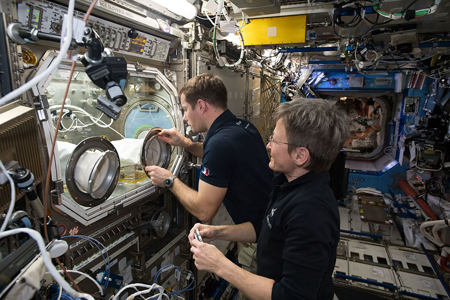
The International Space Station (ISS) is an internationally cooperative mission of about 20 countries that began in November of 2000. The station has been continuously occupied for over 18 years. The ISS provides research in micro-gravity, and exposure to the local space environment. Crew members conduct tests relevant to biology, physics, and astronomy. Even studying the experience and health of the crew itself advances space research. Pictured to the left are two astronauts working on the Micro-gravity Expanded Stem Cells (MESC) experiment. The ISS has been and is our main space research facility.
NASA’s Human Research Program (HRP) is committed to preserving the health and vitality of the crew that will someday touch down upon Mars. While space travel hazards present significant challenges, they also offer opportunities for growth and innovation in technology, medicine and our understanding of the human body. One human challenge explored, one step closer to Mars.
NASA's HRP is dedicated to discovering the best methods and technologies to support safe human space travel. HRP enables space exploration by reducing the risks to astronaut health using ground research facilities, the ISS, and simulated environments. This leads to the development of a biomedical program focused on human health and performance; the development of travel countermeasures; and advanced habitability technologies. HRP promotes scientific human research by funding more than 300 research grants to respected universities, hospitals, and NASA centers. These programs support over 200 researchers in more than 30 states. Top
When Will Humans Go To Mars?
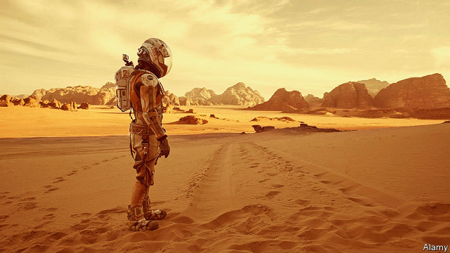
There is quite a bit of controversy about when humans will get to Mars given all the above issues. Almost all of the MARS proposals predict a Moon starting point to save the massive amount of fuel needed to get through the Earth's atmosphere. My prediction is a permanent fully operational Moon/Mars orbiting station (NASA's Gateway or similar) is likely in the mid to late 2020s.
A trip to Mars to "circle the planet" a few times, and then return is predicted by some in the mid 2030s. My personal thoughts are this round trip will take about 13 months and will not take place until the very late 2030s. A "landing" of humans on Mars for some period of time and then a return trip back (3 year round trip) is not likely until after 2050.
Some predict the first humans to land on Mars will "not ever" return to Earth, but will spend the rest of their lives on Mars. This could happen in the 2040s if some brave people are willing to sacrifice all in order to be the first Mars permanent inhabitants.
The projections in this section are the personal opinions of the author and do not represent the opinion of any other person or organization.